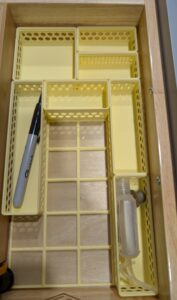I have several 3D Printers now. All of them have had problems at some point. Printers heat plastic to high temperatures, have a series of motors to move the pieces around…these are parts that wear over time. I’m not surprised that things fail over time.
I own two Anycubic Kobra 2 Printers. The Kobra 2 Plus and recently I bought the Kobra 2 Max. Both were purchased during good sales, so below MSRP. These are the exact same printer, except can print up to 320mm, the other 420mm. In the modern age, 3D Printers are starting to have cameras built in to monitor the print remotely. The Kobra series, even the new Kobra 3 line, offers a port to add a camera, and they sell it an inexpensive one as an accessory, but it is not included standard.
The Kobra 2 Plus has been a workhorse. It hasn’t broken, it rarely clogs and I only had to replace a degraded piece once. The Max, after calibration, has been about the same. There are opportunities to improve the print quality slightly with setting changes, but it is reliable. Reviews however, have gone both ways, with people either finding the Kobra 2 line wonderful or horrible.
After using the Plus for a long period of time, and getting the Max, I opted to finally get the camera. The device shows it detects a camera is connected, but it can’t be viewed in their Android app. It asked me to check if a camera was connected. When I had temporarily plugged in a Logitech camera to the Plus last year, it did work. I tried other cameras, and same. So, I assumed this was a software issue, and contacted Anycubic Support.
At the point I write this, I have been talking to them for the nearly the whole month. The rep has ignored every question I asked, continually asked questions I already answered, and finally, decided that I must need a new motherboard. When I asked if he meant two new motherboards, and asked how that would help the situation, he asked if I’d modified the printers in any way, which I hadn’t. Not that I didn’t consider it, considering that the software support for the Kobra 2 line is so limited that I transfer files to the printers on a USB drive, despite them having network connections.
Let’s contrast that with Elegoo. I also own a Centauri Carbon. It is a newer printer that was the rage to preorder this spring and summer. It produces high quality prints, and worked solidly to the point I picked it to print more and more. And it supports network printing from Linux, my chosen operating system, so no USB drive. They have no support for the Carbon in their app, but because the Carbon has open network control, someone wrote a third party Android app and I can monitor the built in camera.
So, 100% closed system on one printer, partially closed system on the other one. I am not a purist, but when someone figured out how to get the Kobra 2 line to actually support remote connections, Anycubic’s response was to close the hole, which is indicative of their approach.
The Carbon broke. It suddenly wasn’t printing correctly. It clogged and then wouldn’t work reliably even after I cleaned it up. When I dismantled it, I found the entire hotend assembly, which is the part of the printer that heats and distributes the melted plastic, was bent. I replaced it and contacted Elegoo. They asked for a picture, I sent it to them. They explained to me what they thought happened. They offered me a replacement hotend because the part failed so atypically. They have none in their US warehouse, which is a massive complaint people have about it, they not only offered to send it to me from their Chinese warehouse, they told me that if I got charged duties on the import, they’d reimburse me. They had a tracking number to me quickly.
The Carbon is not without controversy itself. They were so popular at the price point they were shipping out versions, discovering engineering issues, then correcting them for the next batch, leaving some of the earlier people who ordered it with problems. They promised automatic material switcher(AMS) support, but have experienced issues in delivering the product, and they are already launching a Carbon 2. Elegoo has a reputation for abandoning products and moving on to the next thing. But that’s the internet complaining, I have had no issues.
So far, Elegoo has done everything users asked, and risks alienating their customers due lack of long term commitment, but they gave me good support when I needed them. Anycubic produced good hardware, but their support…we are 21 days in and they just asked me for the serial number of the printer. They previously asked for video of the Android app not working…not sure how “Make Sure Your Camera is Connected” as an error message is video worthy.
I have 2 Anycubic Printers, not sure I’m inspired enough to buy from them again. I’ve left relationships with companies for less. There is always Bambu Labs, which people love, and I do like my A1 Mini.


